About New Delhi
| Airports | Climate |
Currency |
Electricity & Voltage |
Language |
| Tips | Safety | Railways | British Monuments |
Moghul Monuments |
| Festivals | Museums | Parks & Gardens |
Shopping |
Additional Link |
|
Delhi is the capital city of the Federal Republic of India. It is one of India's fastest growing cities. It has sprawled over the West Bank of the river Yamuna, straddling the river. The city has two distinct parts, Shannon Old Delhi & New Delhi. Delhi is the 2nd most widely used entry point into the country, being on the route of most major airlines. It is well linked by rail, air and road to all parts of the country. The remains of seven distinctive capital cities - among them Shahjahanabad and Qutub Minar - can be seen. Here, museums, art galleries and cultural centers attract the finest exhibitions.
Delhi lends an historic past and a vibrant present. Delhi has some of the finest museums in the country. Legend has it that the Pandavas, the august heroes of the epic Mahabharata, originally founded Delhi, then called Indraprastha, around 1200 B.C. Present day Delhi is built around the ruins of seven ancient cities. Delhi- the commercial hub has many tourist attractions to offer. Visit vibrant shopping complex of Connaught Place, Delhi Haat for handicraft goods and delicious food bonanza. Pay a visit to Red Fort and Qutub Minar to view the excellence of Mughal architecture. Or just drop in at Janpath- for buying a variety of cheap and best items.
If you are looking for spiritual peace, visit Lotus temple, which is also famous for its marvelous architecture and heavenly beauty. Take a stroll at Rajpath. Or pay a visit to India Gate and Rashtrapati Bhawan for viewing monuments made during British era. Delhi - a canvas that reflects the complexities, contradictions, beauty and dynamism of a city where the past co-exist with the present. Many dynasties ruled from here and the city is rich in the architecture of its monuments. Diverse cultural elements absorbed into the daily life of city have enriched its character. Exploring the city can be a fascinating and rewarding experience. For further information, please visit: http://delhitourism.nic.in |
||||
|
New Delhi has two airports catering to domestic and international flights. The international airport is Indira Gandhi International Airport and is situated 20 Km from the city center. Palam Domestic Airport handles all domestic flights and is located 17 Km from the center of town. Average Flight Times from Major Regions of the World:
Domestic Airline Links:
September to March is the best season to visit Delhi. During the winter temperatures in Delhi have the following ranges: High 93°F (33.7°C), Low 44°F (6.8°C). The average temperature of New Delhi in February is 62°F. Current Temperature:
The Indian Rupee (INR) is the country's national currency. Current exchange rates are approximately 39.00 INR = 1.00 USD, and 57.00 INR = 1.00 EUR. XE Personal Currency Assistant Electricity in India is 240 Volts, alternating at 50 cycles per second. In case the devices you are carrying do not accept 240 volts at 50 hertz, you will be required to carry a voltage converter. There are three basic types of voltage converters available and adaptable to the Indian voltage.
Outlets in India generally accept the following types of plug:
If your appliances plug has any other shape, you will need a plug adapter. The Indian Constitution recognises Hindi in Devanagari script as the official language of central government India. However, English is the principal spoken and written language of the city. Other languages commonly spoken in the city are Hindi, Punjabi and Urdu. Linguistic groups from all over India are well represented in the city; among them are Maithili, Tamil, Kannada, Telugu, Bengali and Marathi.
Indian Railway Links:
Personal SafetyAs in any other big city, it is important to consider personal safety. For this reason:
Be Careful about Food and WaterDiseases from food and water are the leading cause of illness in travelers. Follow these tips for safe eating and drinking:
Diseases from food and water often cause vomiting and diarrhea. Make sure to bring diarrhea medicine with you so that you can treat mild cases yourself. Prevent Insect BitesMany diseases are spread through insect bites. One of the best protections is to prevent insect bites by:
In hotels and restaurants, tips are not normally included in the bill. Some hotels include service charges on their bills. In such cases tipping is not necessary. The standard tip is 10%. In hotels, porters and room service attendants are normally tipped at the end of the stay, though an early tip is likely to get you better service. Tipping of taxi drivers is not customary.
The Secretariat Complex -- Popularly known as the North Block and South Block the present seat of the ministry of Finance and External affairs respectively was the original Secretariat built on Raisina hill. These imposing structures are topped with Chatris on the corners giving it a typical oriental look. Rashtrapati Bhavan & Mughal Gardens -- Formerly the Viceregal Lodge, the building is the highlight of Lutyen's New Delhi and was completed in 1929 at a cost of 12,53,000 pound sterling. Located in an area of 130 hectares, the palace has 340 rooms. At one time, 2,000 people were required to look after the building and serve the Viceroy's household. The lodge also has impressive garden called the Mughal Garden, which is open to public twice in a year, usually in February and March.
Teen Murti House -- The Teen Murti Bhavan housed the first Prime Minister of India, Jawaharlal Nehru. It was designed by Robert Tor Russel, the architect of Connaught Place, and the Eastern and Western Courts on Janpath. The Bhavan was originally the residence of the Commander-in-Chief of the British Forces in India. However, after independence the house was taken over as the residence of Jawaharlal Nehru. And on his death, the house was converted into a national memorial comprising a library and a museum. The library is one of the finest ones for information on modern Indian history. The house gets its name after the Teen Murti (three statues) Memorial, which stands on its extensive grounds. The memorial was built in memory of the Indian soldiers who perished in World War I. The Bhavan is closed to public on Mondays and on all public holidays.
 Kabuli or Khuni Darwaza Kabuli or Khuni Darwaza
To the left of Chandni Chowk; there was once a gate across the road that was called Khuni Darwaza or the Bloody Gate. The British reoccupied Delhi on 20 September 1857 after fierce resistance by rebels. On 21 September 1857 Bahadur Shah surrendered to Hudson at Humayun's tomb. On 22 September three Mughal princes, Mirza Moghul, Mirza Khizr Sultan and Mirza Abu Bakr were brought by Captain Hudson in a bullock-cart and shot dead at Khuni Darwaza near Delhi Gate. He ordered the princes to take off their upper garments and killed them one by one. The three bodies were carried to the Kotwali and stripped off all the clothes except a rag around their loins, and laid on stone slabs outside the building before they were buried. The reoccupation of Delhi was followed by massacre and plunder and it was even suggested that whole city be razed to the ground. Mirza Ghalib, the great Urdu Poet, who was a witness to the killings and plunder wrote in his Dastambu: "GOD ALONE knows the the number of persons who were hanged. The victorious army entered the city along the main road. Whomsoever they met on the way was killed." The "Khuni Darwaza" still stands in its solitary grandeur exactly opposite the main gate of the Maulana Azad Medical College.
 Feroz Shah Kotla Feroz Shah Kotla
The ruins of Ferozabad, the 5th city of Delhi, erected by Feroz Shah Tughlaq in 1354 can be found at Feroz Shah Kotla, just off Bahadur Shah Zafar Marg between the Old and New Delhi. The remains of a mosque and a well can also be seen, but most of the ruins were used for the construction of later cities. Feroz Shah was a great builder and so, this fifth city of Delhi was full of splendid palaces, mosques and gardens. The Tughlaqabad area was woefully short of water and this made the Tomars move westward to Mehrauli. Firoz Shah, Muhammad Tughlaq's successor solved this problem by building his new city on the banks of Yamuna. Kotla was the inner citadel of Firozabad, built like Windsor, with great palaces and a magnificent mosque inspiring Timur's envy. Destroyed by the Mughals, Kotla palaces were reduced to mere ruins, exposing to view the subterranean passages and covered cloisters. One can still see the pyramidal structure topped by the Ashokan Pillar brought from Topra, and a three-tiered baoli. Timur's invasion of Delhi reduced the city to a city of ruins as he took away with him elephants loaded with treasures and costly building material, artists, masons and skilled workmen as prisoners. The Saiyyads and Lodis used Kotla as their citadel. Now more famous for the cricket ground, where many important matches were held.
Tughlaqabad
Lodi's Tomb
Red Fort or Lal Quila (Son-et-lumiere show) -- The mughal emperor, Shah Jahan, after ruling from Agra for eleven years, decided to shift to Delhi and laid the foundation stone of the Red Fort in 1618. It is called so because of the red stone with which it is built, the Red Fort is one of the most magnificent palaces in the world. India's history is also closely linked with this fort. It was from here that the British deposed the last Mughal ruler, Bahadur Shah Zafar, marking the end of the three century long Mughal rule. It was also from its ramparts that the first Prime Minister of India, pandit Jawharlal Nehru, announced to the nation that India was free form colonial rule.
Hauz Khas -- Hauz Khas is the historical battleground where Timur defeated Mohammed Shah Tughlaq in 1398. One can find the remnants of an ancient college and Feroz Shah's tomb here and on the east to a short distance the Moth ki Masjid built in the finest Lodi style. Once an archetypal North Indian Village in the heart of Delhi's urban sprawl, Hauz Khas is now a shopper's paradise successfully marketing the concept of ethnicity in every possible way. Hauz Khas was a large reservoir built by Allauddin Khilji that was once the water catchments for the city. This village is remarkable for both the ancient and charming ruins in the nearby compound looking down on a still, green tank, as well as for the modern and posh shopping complex, which has sprung up around here. The madarsa, tombs and mosque around it built by Feroz Shah Tuglaq still make for an exclusive and exciting experience. Hauz Khas is also the site of India's first Night Bazaar being built by the Ministry of Tourism.
The National Gallery of Modern Art -- Housed in the residence of Jaipur's former maharajas has a superb collection of paintings dating from 150 years ago to the present day. Company School paintings of the 19th and early 20th centuries and the works of Rabindranath Tagore, Jamini Roy and Amrita SherGil hold pride of place amidst exhibits, which give an overview of the evolution of modern Indian paintings and sculpture. The National Museum and the National Gallery of Modern Art periodically organize special exhibitions.
National Rail Museum -- It was built as per plan of British architect M G Satto on 1957, 1st Feb, on the carpet area of 10 acres of land. The museum displays 27 locomotives and 17 carriage. The saloon car of the Maharaja of Baroda (1886), the carriage of the Maharaja of Mysore made of teak covered with ivory; the cabin of the Prince of Wales (1876), the carriage in which the ashes of Gandhiji was carried in 1948; Fairy Queen of 1855 (oldest steam engine in the world); evolution of Indian Rail from steam engine to present era are vividly displayed. Even, the skull of an elephant who struck a Mail train in 1894, with his head is also projected here in the exhibition. The Toy train is running - you may buy here as a souvenir of your visit. Restaurant and Libraries are also there. The Nehru Memorial Museum - Located at Teen Murti House where Jawaharlal Nehru lived for 16 years till his death in 1964. Its special charm is that the rooms have been preserved as they were. Not far from here is the Indira Gandhi Memorial where one gets a glimpse of the life of the late Prime Minister. Indira Memorial Museum -- Another national museum has been built at 1 Safdarjung Rd in memoriam of Indira Gandhi, on May 27, 1985. Her own bodyguard assassinated Indira Gandhi on 31 Oct 1984. A glass cage has covered the spot where her body fell down. Before being bullet sprayed in from point blank range, Indira was on her way along the garden road out of her residence. At that place Czechoslovak Govt made a artificial water flow by crystal on steel plate of 33´25 m. The crystal stream on the steel plate is designed and planned by the Czech architect Jaroslav Mirich. 3 rooms are full with articles, which were in use by Indira. Photographs of Indira are also there. The bloodstained sari and other dress materials of Indira are chemically preserved in the museum. You may go inside the private chambers to view reading room, dinning room, Dewan-i-Aam, Dewan-i-Khas etc. Open everyday from 10:00 to 17:00 (except Monday) 3010094. The Gandhi Memorial Museum - It has a collection of memorabilia on Mahatma Gandhi.
Dolls Museum -- Shankar's International Dolls Museum was founded in 1954. More than 6000 Variety representing almost 85 countries of the world is on display in the museum. Dolls of Japan deserve special mention. However, 1/3 of total dolls are Indian - Indian ultural and the cultural life style has been projected in the fashions of dolls. Besides, there is B C Roy Children's Library and children's play corner. The doll museum is situated at Nehru House close to Income Tax Office at Bahadur Sah Zafar Marg near Delhi Gate.
The Crafts Museum at Pragati Maidan has galleries displaying India's rich tradition of handicrafts. An added attraction is the presence of craftsperson who are bought here from different parts of the country to demonstrate their skills. The Tibet House Museum on Lodi Road has a fine collection of tankhas, jewellery and ritual objects. En route to Old Delhi are the Shankar's Dolls Museum of Archeology related to the Mughal era, and the Museum of Arms and Weapons which traces the development of arms from the Mughal age to the First World War. National Science Museum - The science museum next to the Pragati maidan, is a great place for both kids & adults to learn and decipher the various mysteries of life hrough science.
Shalimar Garden -- It is one of the most important Mughul gardens in the city. The Shalimar Garden, which lies in the suburbs of the city, was once the first-night staging post for the Mughuls on their way to Kashmir and Lahore. In 1658, Aurangzeb was crowned emperor here. Shish Mahal, the beautiful central pavilion built by Shah Jahan is now in a fairly advanced state of decay. Some of the original painted flower decoration has survived. Tickets: Available at the site and Delhi Tourism office.
Rose Garden - National Rose Garden is situated in the Chanakya Puri area of the capital. This garden has some of the rare and imported rose variety. The best season to visit this garden is during December / January when the flowers are in full bloom. There is another rose garden in Hauz Khas opposite Safdarjang's Tomb.
Lodi Gardens -- In these well-maintained gardens are the domed tombs of Sayyid and Lodi rulers. This garden is known for its fountains, ponds, flowering trees, blossoming shrubs and artificial streams. In the middle of the garden is Bbara Gumbad (Big Dome), a mosque built in 1494. National Zoological Park -- The Delhi zoo, close to Purana Qila, near ITO, was established in 1959 and is spread over a massive area of 214 acres. Is regarded as one of the finest zoos in Asia and efforts have been made to provide an almost natural habitat to the animals and birds. There are more than 2,000 animals and bird species from places like Africa, America, Australia and even Asia. There is a lot of greenery around the zoo and it is an ideal picnic spot especially in winter. Timings summer 0800 to 1800 hours, winter 0900 to 1700 hours. Closed on Friday. Buddha Jayanti Park -- At Palam-bound Sardar Patel Marg via Karol Bagh opp. Assam House is Buddha Jayanti Park founded on the auspicious eve of 2500 years of completion of Buddhas Great Salvation. A plant of Bodhi-Briksha was brought from Sri Lanka and planted in the commemorating park. The park is full of flowers and the garden is pleasant and charming for rest and walk. Ideal for picnic. Musical Fountain -- Delhi Tourism's musical fountain at Ajmal Khan Park is spread over an area of five acres and provides a refreshing getaway from the bustle of the city. The scintillating lights synchronised with music, and the cascading water turn this complex into a quiet haven, particularly during the heat of summer. If you are travelling with kids or just want to enjoy a pleasant evening with your partner, then pay a visit to the Musical Fountain at Ajmal Khan Park This is spread over an area of five acres and provides a refreshing getaway from the bustle of the city. The musical fountain is in operation for two hours every day after sunset except on Tuesday. Nehru Park - A park opposite the Ahoka Hotel & at one end of the diplomatic enclave is not just a regular jogger's park or children's park but also a popular venue for many cultural & classical music functions. It is spread over an area of 85 acres landscaped. Popular picnic spot.
Garden of Five Senses, Saidulazab A beautiful Garden with fountains, sculptures, fragrant frangipani trees & nooks & corners to explore this garden surely fills all the five senses to the brim. Tucked inside Saidulazab off Mehrauli road, this garden has an unique touch of an architects dream.
Millenium Park-- A new entrant to the picnic spot cum, childrens park, cum entertainment & cultural parks in Delhi is the upcoming Millenium park at the Nizamuddin crossing on Mthura Road. More Information About Parks and Gardens in Delhi
Basant Panchami: The biting winter winds continuing till the end of January-early February, when the Hindu festival of Basant Panchami welcomes the spring. This is also the chosen day to worship goddess of learning, Saraswati. Many schools & Bengali communities celebrate this day. Thyagaraja Festival: An enthusiastic display of south Indian music and dance, opposite Jawaharlal Nehru University in Vaikunthnath temple.
Delhi is a veritable paradise for shoppers, who can buy objects ranging from the simplest of Indian handicrafts to international designer labels, and often within the same shopping area. Delhi is unique in that it has representative outlets for the handicrafts of each Indian state. This in it self presents a staggering array of goods, and at very affordable prices. In the last decade there has been a dramatic change in Delhi's markets.
Upwardly mobile lifestyle has led to greater sophistication in display and upgrading of various markets in terms of availability of items. Delhi has long been the most important trading centre in Northern India. Many of its localities, like Sheikh Sarai and Yusuf Sarai, derive their names from medieval market towns, which serviced the bygone, shifted capital cities of Delhi. Today, all of these have become a part of the rapidly expanding etropolis. Instead of market towns, there are specific wholesale markets or quot;mandi" scattered throughout the vast city, and theirs is another story. For visitors to Delhi, shopping is high on the list of things to do. Tourists find a wide choice of items- such as carpets, silks, jewelry, leather and silver ware, handicrafts and hand printed cotton - that are synonymous with India. Each item is available in a range of prices, depending on the quality and the outlet. Another nteresting is that each market has its own, distinctive ambiance and adds its own flavour to the experience of shopping. Haus Khas Village, Connaught Place and Chandni Chowk are worlds apart from one another, yet each of them reflects an aspect of this many - faceted city. In fact one of the fascinating ways of understanding a city is by wandering through its market places for it is here that contemporary culture is most visible to the outsider.
Connaught Place (Closed on Sundays)-- One of Delhi's most popular shopping centres built as early as 1931 there is nothing that one cannot buy here and it also has several eating-houses. The state emporia buildings are also located in this area so are the head offices of major banks, airlines and other such things of importance to the tourist. The complex popularly referred to as CP is an important meeting point for all sections of people and is something, which no tourist should miss if for nothing else then for its architecture and the humdrum of everyday life.
The Cottage industry Emporium (Closed on Sunday) - Right in the heart of Connaught place is the govt. run one place mall for every kind of art craft products made in India. Right from jewelry, silk, sarees, furnishing, carpets, furniture to toys, trinkets, clothes, tea, silver, sandalwood, pottery and brass items. Khadi Gram Udyog (Closed on Sunday) - Khadi a revolution in weaving initiated by Mahatma Gandhi has come a long way in the last century. It is no longer just some thick cloth and the Gandhi topi or kurta. The Khadi Gramudyog bhavan stores all the products like khadi cloth, ready-made and embroidered clothes, silk and woollen clothes, natural, food products, incense, shoes and crafts etc. Also it houses a huge section only dedicated to various types hand made paper for art and craft purposes. From Oct 2, every year the Khadi gives heavy discounts on it's products for a month, on the occasion of Gandhi Jayanti celebrations. State Govt. Emporia, Baba Kharak singh Marg (Closed on Sunday) - Just the corner form the Khadi bhavan, opposite the Hanuman Temple is the Emporia Complex. Starting from 'Gram shilp' in one street are the emporium shopping malls for all the different states of India. For all authentic regional craft and silk one can directly go to any of these govt. emporiums. And of course the Delhi emporium has something from every state. Hanuman Temple - a good place to put mehndi, or henna on the hand and feet. Crafts Museum Shop (Closed on Sunday) - In the corner of Pragati Maidan, diagonally opposite the Old Fort is the crafts Museum. Inside the museum the craftsmen showcase their talent while the shopper can, not just buy but also see how it was made. There is a small shop to sell the same craft items. Sarojini Nagar (Closed on Monday) - A similar market as the Janpath market, located in south Delhi. Dilli Haat - Food and Crafts Bazaar, opposite INA Market, is a one-stop shopping place for tourists, which not only offers various arts and handicrafts of India, but also a taste of the ethnic cuisine. Visitors can also witness the different performing arts of the country. Qutub Shopping arcade -- A more up market outlet for Indian handicrafts and antiques is the bazaar near the Qutab Minar. Ansal Plaza / Greater Kailash / South extension markets/ Lajpat Nagar Central Market (Closed on Monday) - Upscale market for all types of goods starting from clothes to electronics. With several malls and restaurants, these are great places to hang around. Hauz Khas Village - The haunt of the nouveau riche, these markets offer a combination of ethnic chic and designer labels, Indian and international. Hauz Khas Village has set a very interesting trend as market. Over the centuries, a village had developed around the medieval college and the tomb of Firoz Shah Tughlaq. A few years ago, an association called Dastakar - set up a showroom in the village. Now the village has a plethora of boutiques, galleries and restaurants, which coexist with the buffalo, cow pats and men smoking hookahs on charpoys. Far from being a deterrent, the "rural" ambience is a positive attraction. Other villages like Mehrauli, Khirkee and Lado Sarai are fast following suit. Walk into the quaint shops to find the most exquisite handicrafts, trinkets along with the most renowned designer clothes stores of India. Also in the village are some good eating joints for the traveller to explore. The Santushi Shopping Arcade - This shopping complex opposite the Ashoka Hotel has become another popular up market haunt. Developed by the Air Force Wives Association, it has a selectnumber of boutiques where apparel, furnishings and accessories are available. A restaurant and patisserie add to the quiet charm of the place. Chor Bazaar (only on Sunday) - Behind Red fort there is a weekly market, which sells old and antique things. If not for buying one can go there to just have walk around the flea market & who knows you could find a treasure. Weekly book Market (only on Sunday) - On Sundays the Darya Ganj Street comes alive with hundreds of shops & buyers browsing the old books Market. Delhi Tourism India Tourism Indian Software Industry |



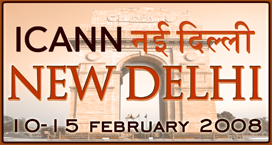
 India Gate -- Built as a memorial to commemorate the 70,000 India soldiers killed in World War I, India Gate was designed by Sir Edwin Lutyens and completed in 1931. Located on Rajpath, the road that leads to the magnificent Rashtrapati Bhawan, the gate is 160 feet high with an arch of 138 feet. Built from sandstone, the arch also houses the Eternal Flame, a gesture in memory of the Indian soldiers who laid their lives in the 1971 war with Pakistan.
India Gate -- Built as a memorial to commemorate the 70,000 India soldiers killed in World War I, India Gate was designed by Sir Edwin Lutyens and completed in 1931. Located on Rajpath, the road that leads to the magnificent Rashtrapati Bhawan, the gate is 160 feet high with an arch of 138 feet. Built from sandstone, the arch also houses the Eternal Flame, a gesture in memory of the Indian soldiers who laid their lives in the 1971 war with Pakistan. 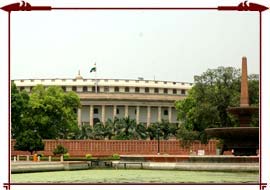 Parliament House -- The seat of Indian Parliament is a marvelous piece of architecture designed by the famed architect Lutyens and constructed under the direct supervision of Sir Herbert Baker. Visitors are not allowed to loiter inside the building without special permission, for security reasons. For the foreign visitors permits are given only after they obtain an introductory letter from the respective embassy. Designed as a circular structure, the House is 171 meters in diameter and about one-third of a mile in circumference. The two semicircular house chambers flank the Central Hall with its impressive dome. The building has a continuous open corridor on the first floor fringed with a colonnade of 144 creamy sandstone pillars. The exterior walls of red sandstone are carved in geometric patterns that echo Moghul jaalis. It is a marvellous piece of architecture which can be admired only from outside on account of security restrictions. It is domed almost circular structure about a kilometer in circumference and is the seat of the Indian Parliament. During the sessions of Parliament there is a flurry of activity in and around the structure.
Parliament House -- The seat of Indian Parliament is a marvelous piece of architecture designed by the famed architect Lutyens and constructed under the direct supervision of Sir Herbert Baker. Visitors are not allowed to loiter inside the building without special permission, for security reasons. For the foreign visitors permits are given only after they obtain an introductory letter from the respective embassy. Designed as a circular structure, the House is 171 meters in diameter and about one-third of a mile in circumference. The two semicircular house chambers flank the Central Hall with its impressive dome. The building has a continuous open corridor on the first floor fringed with a colonnade of 144 creamy sandstone pillars. The exterior walls of red sandstone are carved in geometric patterns that echo Moghul jaalis. It is a marvellous piece of architecture which can be admired only from outside on account of security restrictions. It is domed almost circular structure about a kilometer in circumference and is the seat of the Indian Parliament. During the sessions of Parliament there is a flurry of activity in and around the structure.
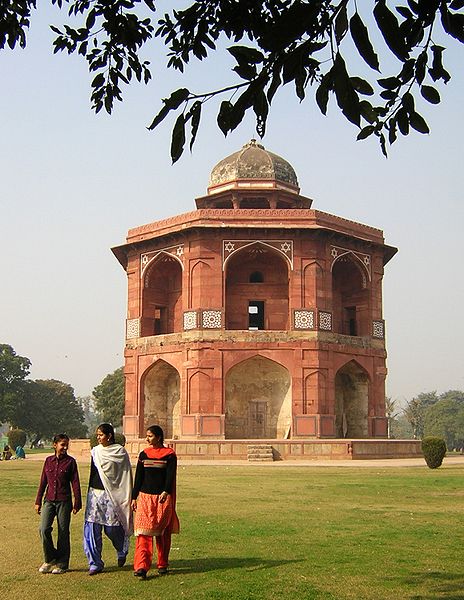 Old Fort or Purana Quila
Old Fort or Purana Quila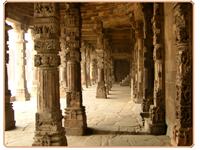 Qutab Minar
Qutab Minar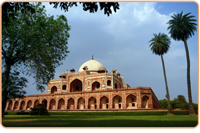 Humayun's Tomb --The Mughals brought with them a love for gardens, fountains and water. The first mature example of Mughal architecture in India, Humayun's Tomb was built by the emperor's grieving widow, Haji Begum, in 1565 AD. Constructed with red sandstone and ornamented marks the beginning of a new tradition of ornate style, which culminated in the Taj Mahal of Agra. Designed by the Persian architect, Mirza Ghyas, Humayun's Tomb shows a marked shift from the Persian tradition of using coloured tiles for ornamentation. Located in the midst of a large square garden, screened by high walls, with gateways to the south and west, the tomb is a square tower surmounted by a magnificent marble dome. The dome stands 140 feet from the base of the terrace and is topped with a copper pinnacle. In addition to the remains of Humayun, the complex also houses the grave of many other distinguished members of the Mughal dynasty.
Humayun's Tomb --The Mughals brought with them a love for gardens, fountains and water. The first mature example of Mughal architecture in India, Humayun's Tomb was built by the emperor's grieving widow, Haji Begum, in 1565 AD. Constructed with red sandstone and ornamented marks the beginning of a new tradition of ornate style, which culminated in the Taj Mahal of Agra. Designed by the Persian architect, Mirza Ghyas, Humayun's Tomb shows a marked shift from the Persian tradition of using coloured tiles for ornamentation. Located in the midst of a large square garden, screened by high walls, with gateways to the south and west, the tomb is a square tower surmounted by a magnificent marble dome. The dome stands 140 feet from the base of the terrace and is topped with a copper pinnacle. In addition to the remains of Humayun, the complex also houses the grave of many other distinguished members of the Mughal dynasty.
 Jantar Mantar -- At first sight, the Jantar Mantar appears like a gallery of modern art. It is, however, an observatory. Sawai Jai Singh II of Jaipur (1699-1743), a keen astronomer and a noble in the Mughal court, was dissatisfied by the errors of brass and metal astronomical instruments. Under patronage from the emperor, he set on himself the task of correcting the existing astronomical tables and updating the almanac with more reliable instruments. Delhi's Jantar Mantar is the first of the five observatories that he built with large masonry instruments. The observatory has the Samrat Yantra, a simple equal hour sun dial, the Ram yantra for reading altitudinal angles; Jai Prakash for ascertaining the position of the sun and other celestial bodies, and the Misra Yantra which is a combination of four scientific gadgets.
Jantar Mantar -- At first sight, the Jantar Mantar appears like a gallery of modern art. It is, however, an observatory. Sawai Jai Singh II of Jaipur (1699-1743), a keen astronomer and a noble in the Mughal court, was dissatisfied by the errors of brass and metal astronomical instruments. Under patronage from the emperor, he set on himself the task of correcting the existing astronomical tables and updating the almanac with more reliable instruments. Delhi's Jantar Mantar is the first of the five observatories that he built with large masonry instruments. The observatory has the Samrat Yantra, a simple equal hour sun dial, the Ram yantra for reading altitudinal angles; Jai Prakash for ascertaining the position of the sun and other celestial bodies, and the Misra Yantra which is a combination of four scientific gadgets.
 The National Museum on Janpath -- It is the premier repository of antiquities. Built in 1960, it has an extraordinary collection representing the entire span of Indian civilization from pre-historic times. Its galleries include finds from the Indus Valley Civilization, superb sculptures in stone, and bronzes from the Chola period, the largest collection of miniature paintings in the world, manuscripts, a Buddhist Gallery, including relics of the Buddha from Piprahwa, the exquisite Jewellery Gallery, the Anthropological Gallery of tribal art; galleries devoted to decorative and applied arts, Maritime Heritage and Pre-Columbian art, and the Central Asian Antiquities, Gallery of Auriel Stein's finds along the ancient Silk Route (the great murals however, are on display at the adjacent Archaeological Survey of India).
The National Museum on Janpath -- It is the premier repository of antiquities. Built in 1960, it has an extraordinary collection representing the entire span of Indian civilization from pre-historic times. Its galleries include finds from the Indus Valley Civilization, superb sculptures in stone, and bronzes from the Chola period, the largest collection of miniature paintings in the world, manuscripts, a Buddhist Gallery, including relics of the Buddha from Piprahwa, the exquisite Jewellery Gallery, the Anthropological Gallery of tribal art; galleries devoted to decorative and applied arts, Maritime Heritage and Pre-Columbian art, and the Central Asian Antiquities, Gallery of Auriel Stein's finds along the ancient Silk Route (the great murals however, are on display at the adjacent Archaeological Survey of India).
 The Rail Transport Museum - It is a must for rail buffs. Its vintage display includes the oldest locomotive in the world-still working; the Vice regal Dinning Car (1889) and the Prince of Wales Saloon (1876). Children can enjoy a ride on the miniature rail track located in the south of Delhi close to the diplomatic area of Chanakayapuri it traces, through exhibits, the 140 year-old history of the Indian Railways. The museum, established in 1977, and spread over a ten-acre area, is the first of its kind in India. Timings: summer 0830 to 1130 and 1600 to 1730 hours, winter: 0900 to 1730 hours. It is closed on Mondays.
The Rail Transport Museum - It is a must for rail buffs. Its vintage display includes the oldest locomotive in the world-still working; the Vice regal Dinning Car (1889) and the Prince of Wales Saloon (1876). Children can enjoy a ride on the miniature rail track located in the south of Delhi close to the diplomatic area of Chanakayapuri it traces, through exhibits, the 140 year-old history of the Indian Railways. The museum, established in 1977, and spread over a ten-acre area, is the first of its kind in India. Timings: summer 0830 to 1130 and 1600 to 1730 hours, winter: 0900 to 1730 hours. It is closed on Mondays.
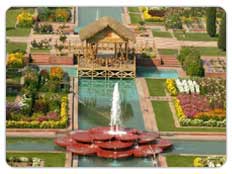 The Mughal Garden -- The famous Mughal Gardens is located in the premises of the Rashtrapati Bhavan - the official residence of the President of India. The building and gardens designed by Sir Edwin Lutyens span an area of about 320 acres that include colourful flowering shrubs and European flowerbeds. The gardens comprise of the Rectangular Garden, Long Garden and the Circular Garden. The Rectangular Garden is the formal garden, which derived its treatment from the water-gardens, which the Mughals brought into Delhi. The small flowerbeds, the four waterways and mown lawns produce a virtual paradise. The gardens are open to the public from February to March every year.
The Mughal Garden -- The famous Mughal Gardens is located in the premises of the Rashtrapati Bhavan - the official residence of the President of India. The building and gardens designed by Sir Edwin Lutyens span an area of about 320 acres that include colourful flowering shrubs and European flowerbeds. The gardens comprise of the Rectangular Garden, Long Garden and the Circular Garden. The Rectangular Garden is the formal garden, which derived its treatment from the water-gardens, which the Mughals brought into Delhi. The small flowerbeds, the four waterways and mown lawns produce a virtual paradise. The gardens are open to the public from February to March every year.
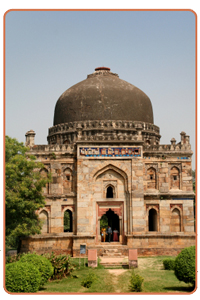

 Chandni Chowk (Closed on Sundays)-- It was the eyes and ears of the Mughal's commercial instincts and is today one of the country's best known wholesale markets for textiles, electronic goods and watches. The entire area was designed by Jahanara Begum, Shah Jahan's favorite daughter and was then inhabited by the well-to-do families of that time. There is however a word of caution and that is; that there are several elements selling duplicate goods and the tourist needs to be careful about this.
Chandni Chowk (Closed on Sundays)-- It was the eyes and ears of the Mughal's commercial instincts and is today one of the country's best known wholesale markets for textiles, electronic goods and watches. The entire area was designed by Jahanara Begum, Shah Jahan's favorite daughter and was then inhabited by the well-to-do families of that time. There is however a word of caution and that is; that there are several elements selling duplicate goods and the tourist needs to be careful about this.
 Janpath (Closed on Sunday) -- Located in the heart of Connaught Place Janpath is one of the busiest roads in New Delhi. A street market famous for its cheap bargain on cotton clothes & trinkets. Be sure to bargain for the prices. Some famous shoe and music stores are also here in Janpath. A small but fragrant shop here sells original essential oils, in forms of ready to use concentrate perfumes. Loads of junk & glass jewellery shops dot the lane. For a good variety of stoles & scarves Janpath is an ideal choice.
Janpath (Closed on Sunday) -- Located in the heart of Connaught Place Janpath is one of the busiest roads in New Delhi. A street market famous for its cheap bargain on cotton clothes & trinkets. Be sure to bargain for the prices. Some famous shoe and music stores are also here in Janpath. A small but fragrant shop here sells original essential oils, in forms of ready to use concentrate perfumes. Loads of junk & glass jewellery shops dot the lane. For a good variety of stoles & scarves Janpath is an ideal choice.










